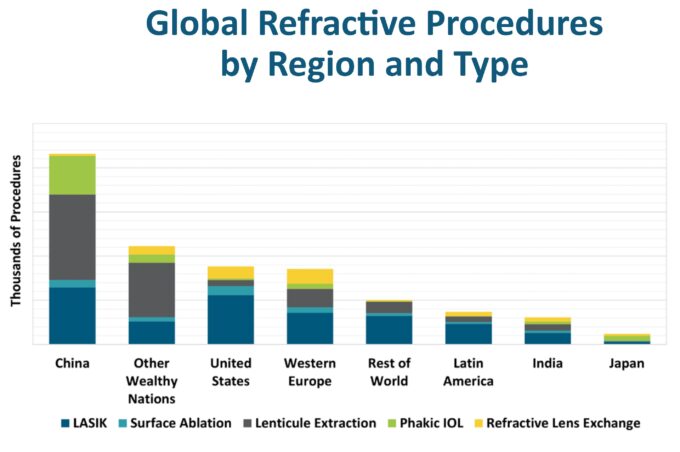Summary: Time price calculations show that LASIK surgery costs have fallen significantly since 1998. Advancements in LASIK technology, such as the transition to bladeless methods and personalized treatments, have enhanced both safety and efficacy. Dr. Gholam A. Peyman’s pivotal patent in 1988 laid the foundation for LASIK innovation, contributing to its increased affordability and accessibility, especially in countries like China and India.
This article was published at Gale Winds on 2/28/2024.
According to Market Scope, the typical cost for LASIK surgery in 2023 was $4,492. This is up slightly from the 1998 price of $4,360. Let’s calculate and compare the time prices to see the true price difference. Unskilled hourly compensation in 1998 was around $7.75, indicating a time price of 562.6 hours. Unskilled hourly compensation is closer to $16.15 today, indicating a time price of 272.1 hours. The time price has fallen 51.6 percent. You get 2.07 eyes corrected today for the time it took to earn the money to correct one in 1998. LASIK has become 107 percent more abundant.
LASIK is the acronym for laser-assisted in situ keratomileusis. Keratomileusis is the medical term for corneal reshaping. Clearsight.com reports:
LASIK technology has significantly advanced since its inception. The initial blade-based approach has been replaced by the bladeless method, using femtosecond lasers for increased precision. Wavefront and topography-guided technology now allow for personalized treatment, while sophisticated eye-tracking systems enhance the surgery’s accuracy and safety. The remarkable advancements have not only improved visual acuity but also enhanced the overall quality of visual perception, offering patients the ability to see the world around them more clearly and vividly.
While thousands of ophthalmologists and researchers from all over the world have been involved in advancing the technology, Iranian-born immigrant to the United States Dr. Gholam A. Peyman was awarded the key patent in 1988. He holds over 200 US patents, including for novel medical devices, intraocular drug delivery, surgical techniques, and new methods of diagnosis and treatment. In 2011, President Barack Obama awarded Peyman the National Medal of Innovation and Technology.
Continuous innovation in LASIK technology is making vision correction safer, faster, more precise, and more affordable. If you want to save some money and take a bit more risk, the procedure is around $1,600 in China and under $1,000 in India. China performs the most vision correction procedures on the planet.
Remember, the learning curve ordains that with every doubling of production, costs per unit fall between 20 percent and 30 percent. This is because we discover valuable new knowledge every time we perform the procedure.

As noted, since 1998, LASIK has become 107 percent more abundant in the United States, in contrast to hospital services, which have become 37.7 percent less abundant. Why the huge difference? LASIK has been relatively free to innovate. Perhaps more important, health insurance does not pay for this procedure, and LASIK is globally competitive. We also note that elective procedures have enjoyed much greater abundance growth than insurance-covered surgeries.
When entrepreneurs are free to innovate and compete, prices fall and quality increases. The opposite happens when governments and bureaucrats step in to protect the status quo. Imagine where we would be today if the manufacturers of eyeglasses had prevented the innovation of contact lenses? Or the contact lens industry had prevented LASIK?

